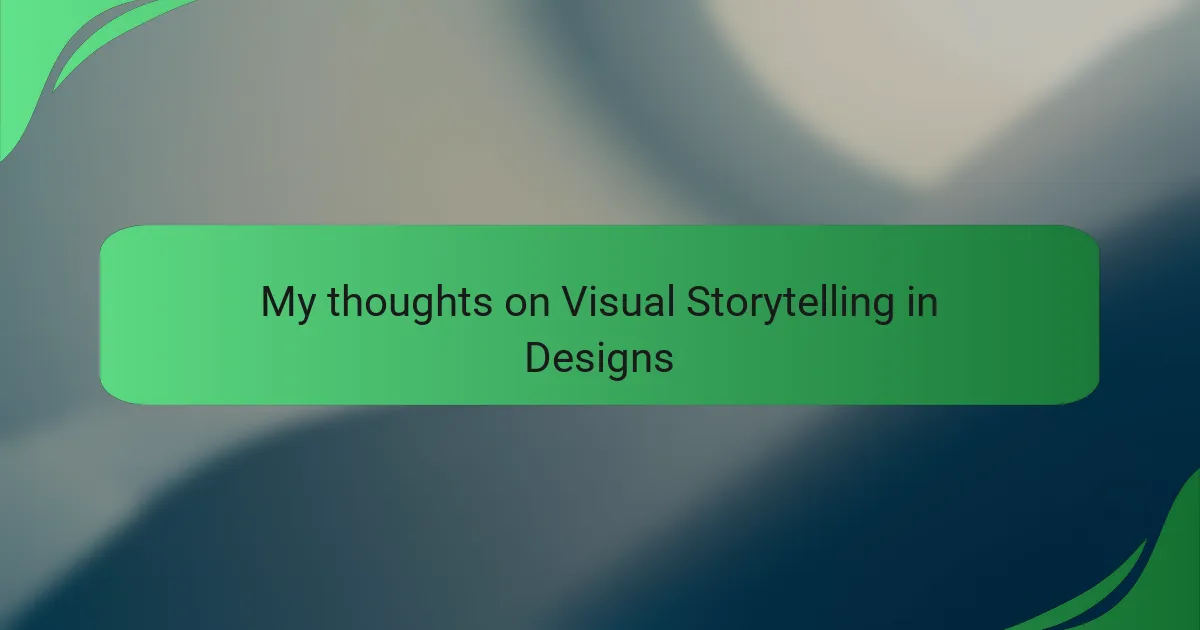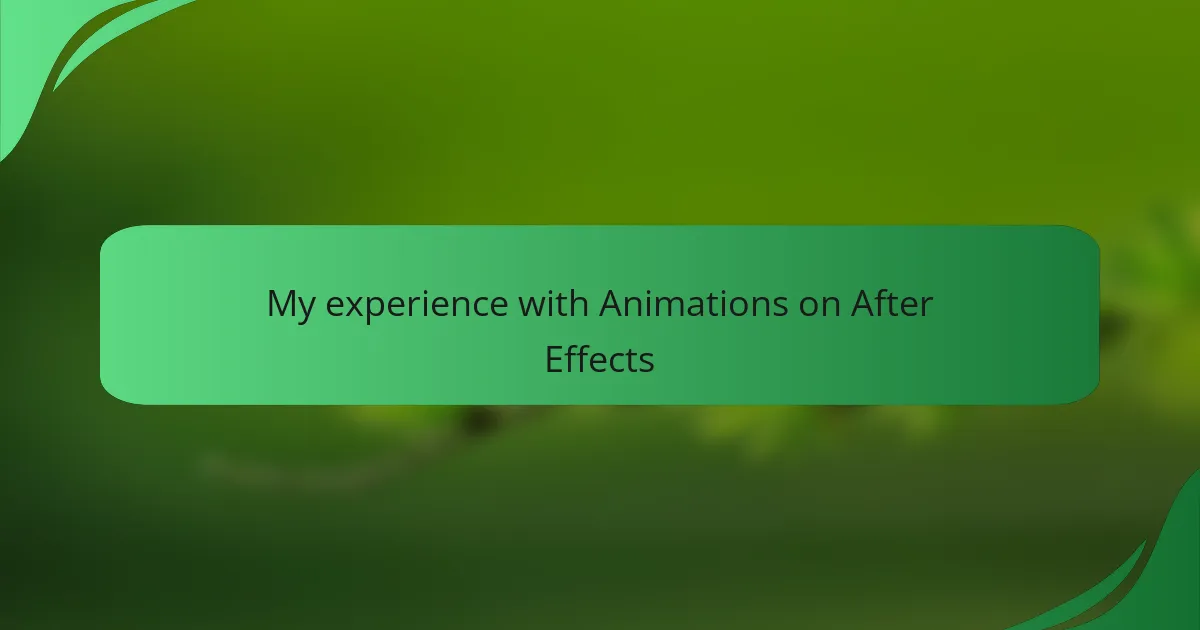Key takeaways
- Visual storytelling enhances engagement by simplifying complex ideas and evoking emotions through images and graphics.
- Key elements include clarity, emotional resonance, and narrative flow to create impactful interactions and memorable experiences.
- Challenges include audience interpretation, balancing aesthetics with functionality, and ensuring consistency across platforms for effective communication.
- Techniques like visual hierarchy, strategic use of whitespace, and interactive elements can significantly improve user experience and navigation.
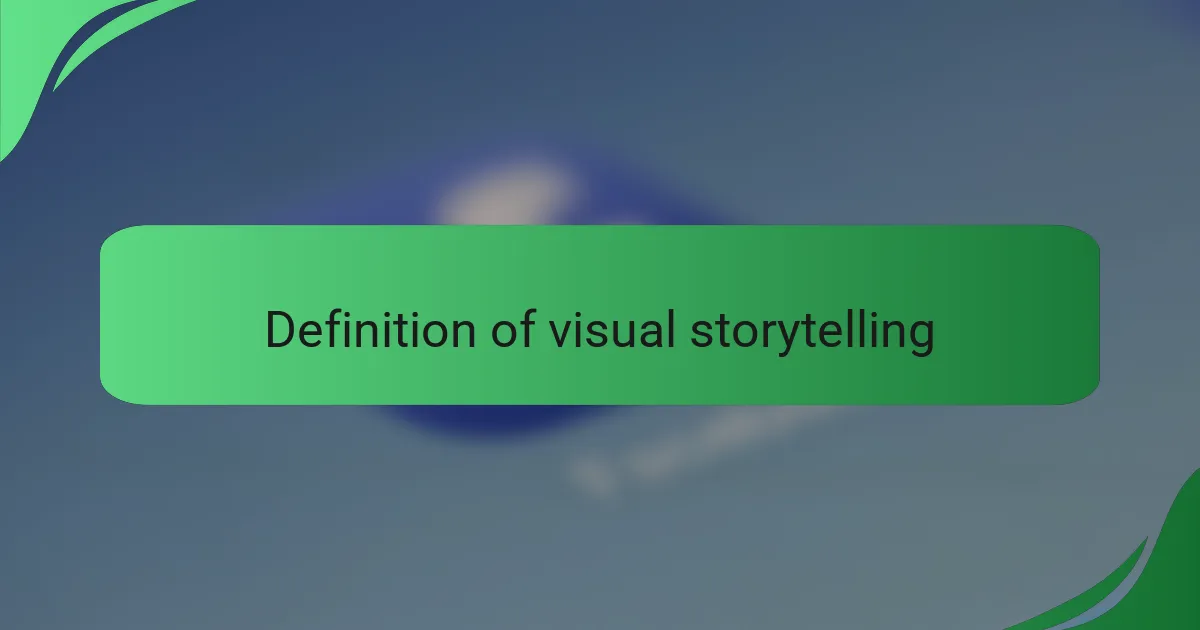
Definition of visual storytelling
Visual storytelling is all about conveying messages and ideas through images, illustrations, and videos. It’s a powerful approach that allows designers to create an emotional connection with their audience. When I think about my own experiences with visual storytelling, I remember moments when a single image or graphic evoked a strong response, much more than words could.
At its core, visual storytelling simplifies complex information and engages viewers in a more impactful way. Personal narratives can be told through visuals, creating a relatable experience. For instance, I once worked on a project where a series of images captured user journeys, and the feedback was overwhelmingly positive, showcasing the true potential of visuals in design.
Here’s a comparison table to highlight how visual storytelling differs from traditional storytelling:
| Aspect | Visual Storytelling | Traditional Storytelling |
|---|---|---|
| Medium | Images, Videos, Graphics | Text, Spoken Word |
| Engagement | High Emotional Impact | Varies by Content |
| Understanding | Quick Comprehension | Requires More Time |

Importance of visual storytelling in design
Visual storytelling holds immense significance in design because it bridges the gap between information and emotion. I recall a project where we used a single compelling image to communicate a brand’s values effortlessly. The feedback was immediate and profound, highlighting how visuals can resonate on a level that text alone often fails to reach. Isn’t it fascinating how a well-crafted visual can stir emotions and ignite curiosity in mere seconds?
Moreover, effective visual storytelling plays a pivotal role in simplifying complex ideas. When I worked with a team on a tech application, we transformed intricate data into engaging graphics. The result? Users found it much easier to grasp the concept. This experience reinforced my belief that a picture truly can be worth a thousand words, especially in a fast-paced digital landscape where clarity is crucial.
Ultimately, visual storytelling helps to create memorable user experiences. I often find myself drawn to designs that tell a story through visuals, as they linger in my mind long after I’ve seen them. It’s a reminder that in the realm of design, we must harness this power to not just inform, but also to connect with our audience on a deeper level. How can we leverage this in our own work? That’s something I continually explore.
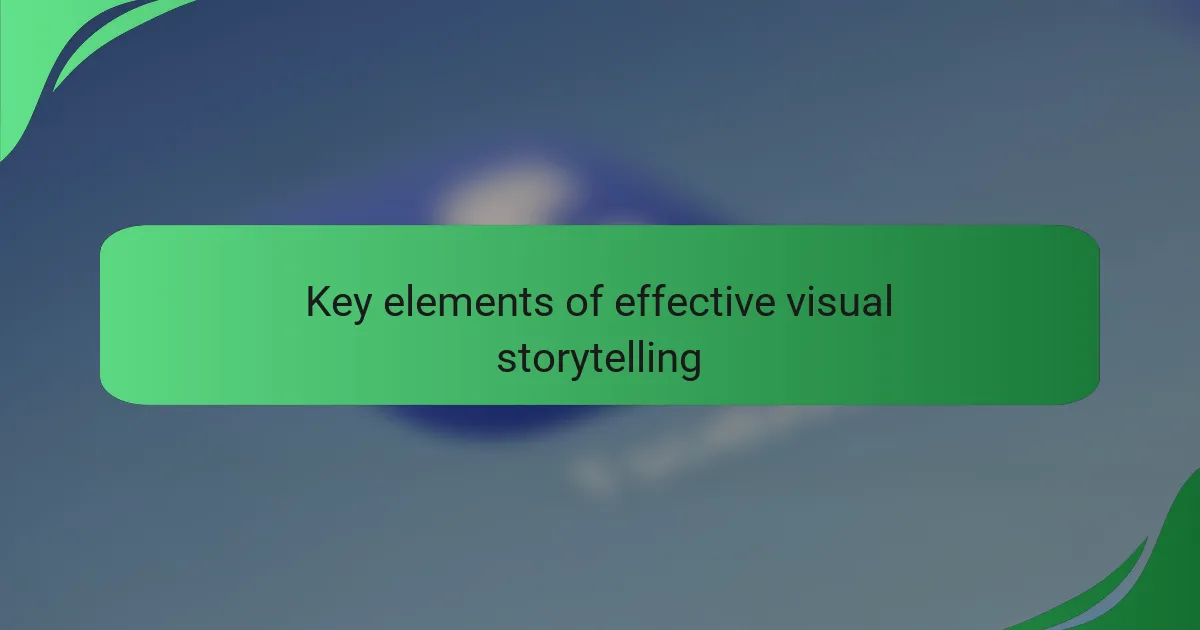
Key elements of effective visual storytelling
Effective visual storytelling hinges on a few key elements. First, clarity is essential. If a visual is cluttered or confusing, it loses its power to communicate. I remember a time when I created a dashboard for an app; simplifying each graphic allowed users to grasp the information instantly. This taught me that every element must serve a purpose, guiding the viewer’s eye where it needs to focus.
Another crucial element is emotional resonance. A well-crafted visual should evoke feelings and forge connections. During a project aimed at promoting mental health awareness, we used evocative imagery that spoke to the struggles and triumphs of individuals. The stories behind those images created a bridge between information and empathy. Isn’t it incredible how a single image can tell a deep story and provoke thought?
Lastly, narrative flow plays a vital role in visual storytelling. It’s like crafting a journey for the viewer, leading them step by step through the content. In a campaign I was involved in, the sequence of images was designed to build anticipation and intrigue. By guiding people through a thoughtfully constructed narrative, we transformed their experience from passive to active engagement. I often ask myself: how can we better orchestrate our visuals to narrate compelling stories? This question drives my creative process forward.
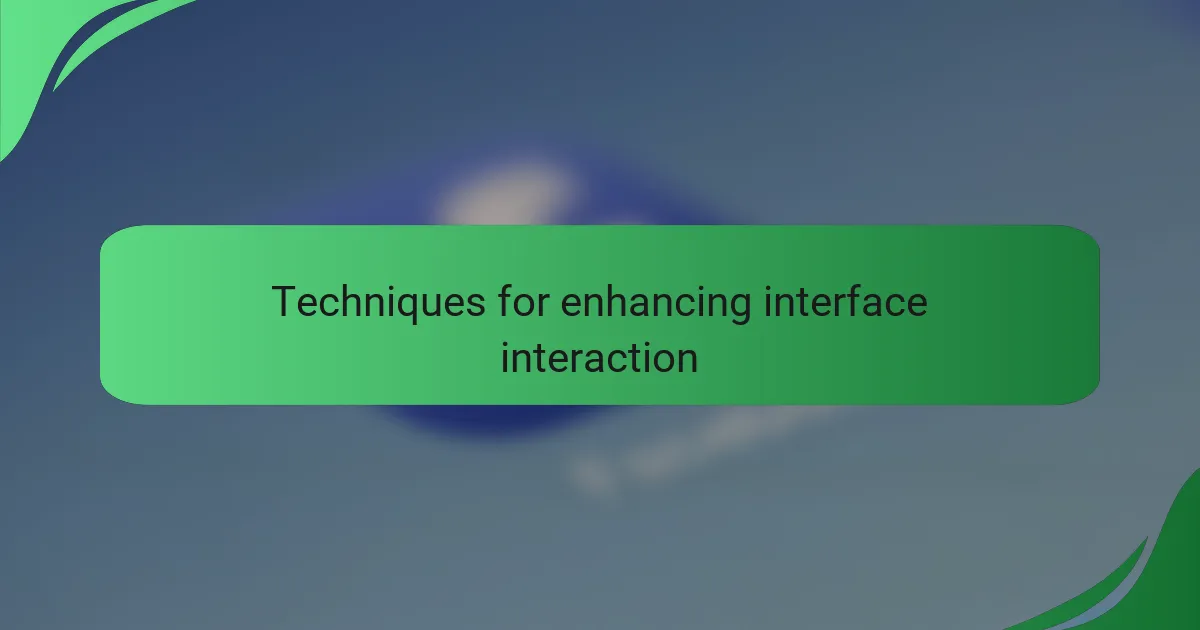
Techniques for enhancing interface interaction
When considering techniques for enhancing interface interaction, I find that simplicity is often the key. In my experience, reducing clutter not only makes navigation intuitive but also allows users to focus on what truly matters. For instance, I once revamped a site with a busy layout, and the feedback was incredible—users appreciated the ease of finding information, which simply made their experience more enjoyable.
Another powerful technique is the application of visual hierarchy. This ensures that users can easily identify the most important elements on a page. During one of my projects, I employed contrasting colors and varying font sizes to draw attention to call-to-action buttons. The result? A significant uptick in engagement levels, which reinforced my belief in the effectiveness of this approach.
- Use whitespace strategically to create breathing room and guide users’ attention.
- Implement interactive elements like hover effects to make the experience feel dynamic.
- Prioritize content layout by using grids or cards for clarity and organization.
- Utilize bold typography for headlines to establish a clear hierarchy visually.
- Integrate visual cues, such as arrows or icons, to direct user actions and decisions.
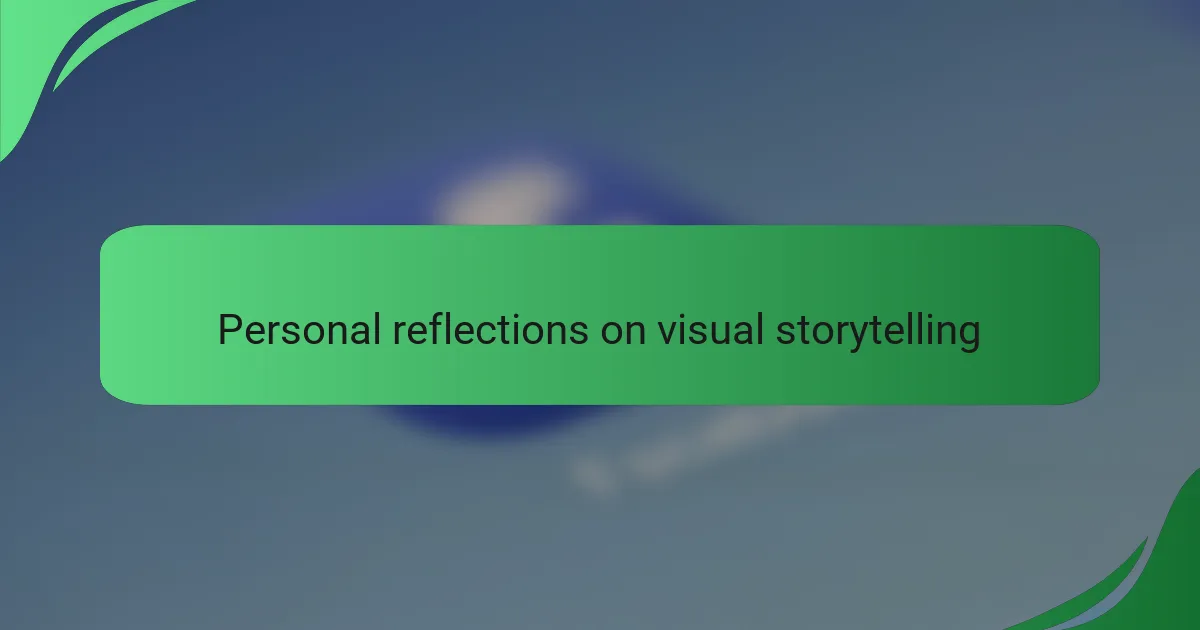
Personal reflections on visual storytelling
Visual storytelling resonates deeply with me, especially in the realm of design. I vividly remember a project I worked on where we transformed a mundane data set into an interactive story. It was exhilarating to see users engaged and connected to the data, as they navigated through elements that unfolded like a narrative. This experience taught me that visuals can evoke emotions far beyond mere statistics, creating a bond between the audience and the content.
In my view, effective visual storytelling can enhance user experience significantly. It helps to clarify messages, engage users on an emotional level, and guide their attention through the design, making complex information easily digestible. Here are some reflections on how it plays a crucial role in design:
- Emotional Connection: Visuals can evoke feelings, making users feel more invested.
- Clarity: Good storytelling provides context that simplifies complex ideas.
- Engagement: A narrative keeps users interested, encouraging exploration.
- Memorability: Stories make information stick, aiding in retention.
- Guidance: Visual cues can lead users step-by-step through interactions, enhancing usability.
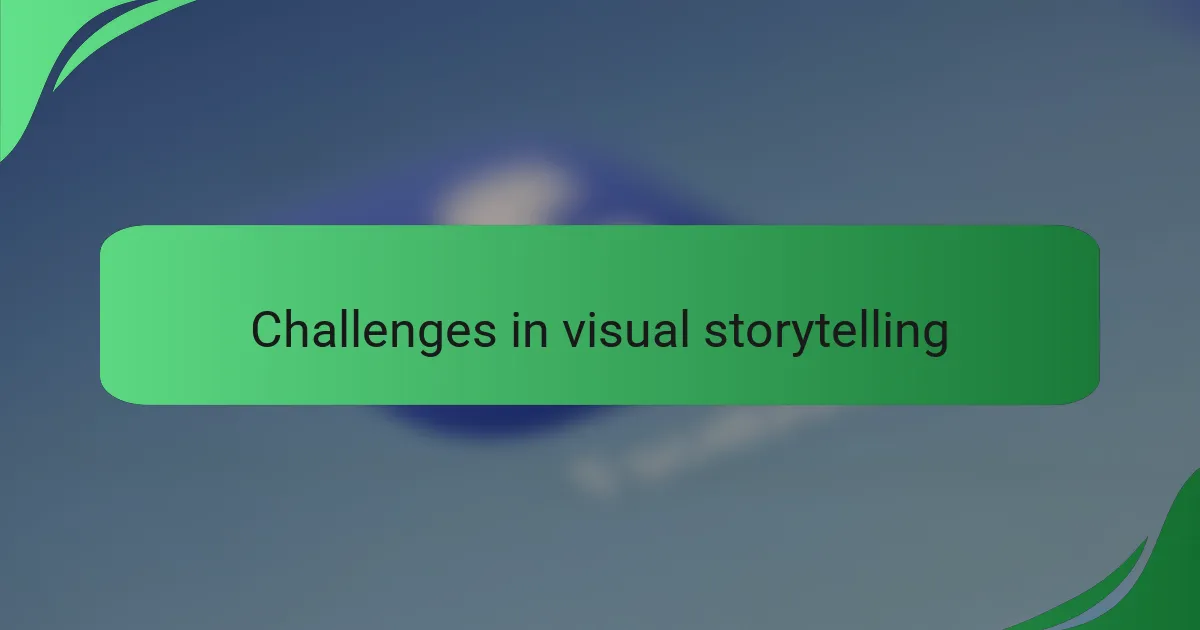
Challenges in visual storytelling
Visual storytelling in design comes with its own set of challenges. One of the primary difficulties is ensuring that the story conveyed through visuals resonates with the audience. Many times, I’ve noticed that what seems clear to a designer can be confusing to a user. This gap in understanding can lead to misinterpretation and disengagement.
Another significant challenge is balancing aesthetics with functionality. While stunning visuals can captivate attention, they shouldn’t overshadow the core message or usability of the design. I’ve often found myself torn between my desire for a visually striking element and the need for a clear user experience. It’s crucial to find that sweet spot where the two coexist harmoniously.
Lastly, consistency across different platforms poses its own hurdles. From a personal standpoint, designing for responsiveness while maintaining a coherent narrative requires attention to detail and adaptability. Every design choice should seamlessly contribute to the overarching story, regardless of the device.
| Challenge | Description |
|---|---|
| Audience Interpretation | Designs may be misunderstood by users, leading to confusion. |
| Aesthetics vs. Functionality | Designs can appear beautiful but may fail in usability. |
| Consistency Across Platforms | Maintaining a coherent narrative in designs for various devices can be challenging. |
